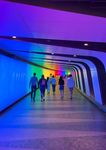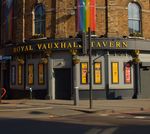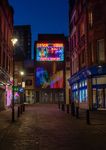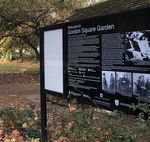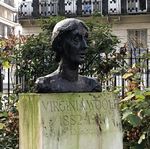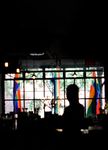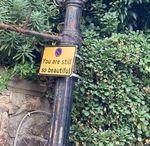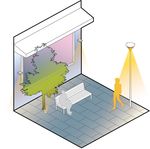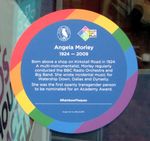Queering Public Space - Exploring the relationship between queer communities and public spaces - Arup
←
→
Page content transcription
If your browser does not render page correctly, please read the page content below
In those 71 countries where same-sex relations are criminalised, necessarily the only queer spaces are private ones. Queering Public Space Arup 2
Why queering public space? In Queering Public Space, a collaboration between Arup and the University of Westminster, we explore the relationship between queer communities and public spaces. As an outcome of this research, we launch this report, in addition to a video project with the same title as a different way to communicate our findings. This short report sums up some of the themes we have explored in 2020- 2021. We ask: what are the key characteristics that contribute to queering public space? How do we protect what remains of queer memory in our cities? And how do we move beyond the gayborhood towards creating public spaces for all? At present, we are conscious that legal regimes around the world limit the applicability of our findings in many settings. In 71 countries same- sex relations between men are criminalised and 43 criminalise lesbian relations as well. In these jurisdictions, necessarily the only queer spaces are private ones. Nonetheless, we hope that, where possible, this research will contribute towards the design of a more welcoming and inclusive public realm. In this report queerness is used in two ways. First, it is used to convey a range of gender identities and sexual orientations which do not conform to heteronormative constructions. Second, importantly, it also connotates a questioning and subverting of the exclusionary consequences of these social constructions, and of the structurers of power and authority which underpin them. Queering Public Space Arup 3
LGBTQ+ people ‘switch’ or hide their identities in order to feel safe in the majority of public spaces. Queering Public Space Arup 4
Introduction
Public space is not always, well, public. In this This inclusivity is particularly needed for
report LGBTQ+ is used to designate people our LGBTQ+ communities, who are often
who are lesbian, gay, bisexual, transgender, absent, underrepresented, or invisible in the
queer or questioning, intersex, pansexual, urban fabric and whose needs are frequently
asexual or otherwise gender or sexual identity overlooked in the planning processes of cities.
non-conforming, many of whom are acutely This is despite the emergence from the 1950s
aware of the hostile nature of public space. A of gayborhoods or gay villages, anchored by
2019 survey showed that 50% of the British bars, restaurants, bookshops and community
public recognise that these groups generally centres and - though in the UK less so -
modify how they present in public space to residential areas (for instance Soho in London,
avoid being targeted. or the Gay Village in Manchester). These
Less well-known is that some, trans people in created a sense of queer place where LGBTQ+
particular, avoid whole areas altogether. Nor identities could be expressed. Yet beyond these
are they the only minority who can feel this gayborhoods many LGBTQ+ people ‘switch’
vulnerability, a vulnerability reinforced by a or hide their identities in order to feel safe in
steady rise in misogynistic attacks, hate crimes the majority of public spaces.
and incidents also directed against disabled Cosmopolitan cities - such as Barcelona,
people and religious and ethnic minorities in Berlin, San Francisco or Sydney - have
the UK in recent years. Our use of the term become the home for gayborhoods that
‘queering’ in this report is not just about evolved during recent decades. But despite
rethinking how public space can be made more the visibility of queer urban spaces in many
inclusive for gender and sexual orientation non- cities, there are fears and concerns about their
conforming people, but for all those groups who structural decline and disappearance. They
currently feel excluded or threatened in such may have attracted tourists in major cities.
spaces. This report accordingly offers some But they also attracted property developers
recommendations for queering the exclusionary and investors who have found economic
nature of too much public space - often during opportunities. Through gentrification and urban
the day as well as after dark - in order to make renewals, layers of memory are erased. Many
it much more inclusive and welcoming for all. of these spaces have become unaffordable to
the queer communities who shaped them.
Despite the emergence of queer
enclaves in many cities across the
world in recent decades, there is an
urgent need today to rethink public
spaces and create more inclusive,
welcoming and hospitable
environments for all members of
our communities.
Queering Public Space Arup 5Our approach The growing interest in creating inclusive public space and the rise in hate crime in recent years indicates a need for interventions which increase the inclusion and acceptance of marginalised groups, not least LGBTQ+ people. Through our approach we explore how LGBTQ+ people can feel more safe and included beyond enclaves in urban public spaces, to establish a set of recommendations to address this deficiency. Our approach to this had four main elements. Third, we also concurrently held three First, although design characteristics were workshops for practitioners within Arup. rarely central to the existing literature, an These enabled us to map current awareness extensive search enabled us to identify both of and examples of a range of approaches to positive and negative design features from the inclusive design, as well as to explore in more public spaces analysed therein. depth particular facets such as the impact of Second, we followed this up with two soundscapes. workshops and a number of one-to-one Fourth, we conducted some surveys of the lived interviews with leading figures in the field experience of LGBTQ+ people in London and of queer geographies and architecture, and their interaction with public spaces, using this with experts on the nature and location of to test hypotheses derived from the existing hate crimes and incidents. These enabled us literature. The result was a rich variety of to test out and refine our developing ideas information about how design facets can on the relationship between design, safety contribute to safer, more inclusive public spaces. and inclusivity. This was supplemented by analysis, as far as possible given the limited data available, of the statistics and reports that illuminate the generally overlooked relationship between locations and hate incidents. Queering Public Space Arup 6
Key recommendations
Rethinking the gayborhood. to preserve the character of sites through
Planners should think beyond the gayborhood listing and requirements built into planning
and move inclusive practice towards LGBTQ+ guidance would help LGBTQ+ people to
people beyond preserving queer places. They recognise themselves in the built environment.
need to incorporate LGBTQ+ inclusion and Additionally, getting the public in general to
safety in public space into their use of devices understand that, despite persecution, LGBTQ+
such as equality impact assessments and into people have always existed and have a history
the practical application of Statements of – marginalised though it has been – may help to
Community Involvement by consulting with undermine the hostility and misunderstanding
LGBTQ+ groups. The needs of such groups that is still widely expressed towards them in
also should be a requirement, particularly when the present.
there is potential loss of amenities for them, in
the planning application process. Designing in desistance and diversity.
Good design should contribute to the desistance
Inclusive practice. of hate crime and incidents. Designing in
Planning, building and project management diversity can also help to usualise marginalised
guidelines (BS8300 and ISO21500) need and disempowered groups like LGBTQ+
to be updated to take into consideration the people, promoting their inclusion in public
requirement for a fuller understanding of space. Ways to do this include attention to
inclusive design. Inclusive design in public the scale and mass of buildings, rooflines,
space and all the publicly accessed facilities colours and facades; the addition of curvilinear
therein goes beyond access and mobility issues aspects; varied sightlines and the break-up of
and should also fully incorporate considerations space; the softening of soundscapes and visual
of poverty, deprivation, and lived experiences, environments through choice of surfaces,
not least of those with protected characteristics greenery and water features; the encouragement
under the 2010 Equality Act. This approach of footfall and pedestrian flow of a varied kind;
should be supplemented by encouraging social design interventions that undermines dominant
enterprises to manage anchor businesses in narratives; the nature, intensity, quality and
sustainable ways, such as by making it easier positioning of lighting.
for them to acquire freeholds. Planners should
also try to provide opportunity for organic Diversify workforces and engage better
development and diversity with support from There is a need to diversify workforces
the Community Infrastructure Levy. and engage with LGBTQ+ communities
when planning and designing spaces in our
Preserving queer heritage cities to better understand the challenges,
Another important means of including needs, aspirations and hopes of LGBTQ+
LGBTQ+ people in public space is by communities. Active community engagement
preserving their heritage. This should and consideration of lived experiences of the
include encouragement to interventions by users of the space should be integrated into
local LGBTQ+ communities to mark their the design. The more diversity people see, the
own heritage in public space, enabling new less they feel threatened by it - if it is not felt
layers of memory and meaning to emerge to undermine their own sense of identity - and
organically in these locations. Helping therefore the more they are likely to accept it.
Queering Public Space Arup 7Queer Heritage
in Public Space
Cities grow and morph historically, with the past
constantly being repurposed in the present. As a result,
1 of 5
statues in the UK
we make sense of our cities through the layers of are of women, only.
memory that tell the story of the past and the people
who shaped it.
Through memorials, statues, monuments, ruins, our cities, and the erasure of queer spaces, how
symbols, commemorative plaques, names of can we protect what remains? And how do we
streets, buildings and neighbourhoods, the queer public spaces through telling the story of
past is spatially and physically brought to queer communities who lived there in the past?
our everyday urban life. This public memory
in space indicates what a society chooses The story of Bloomsbury
to remember as significant. These memory Interventions in the public realm do not
layers, however, are selective. Whilst some always address this erasure: indeed, some may
of them are picked up to be celebrated, listed contribute to it. Bloomsbury, for example, has
and highlighted, others are silenced, hidden a small bust of the bisexual writer Virginia
or erased. What gets preserved is heavily Woolf in a corner of Tavistock Square Gardens.
influenced by those who exercise power over Nearby is a blue plaque to Woolf on one of her
the planning and architecture of our cities. former residences. At the entrance of adjacent
People in authority determine who to remember Gordon Square a sign refers to the Bloomsbury
and where in our public spaces. For instance, Group of early twentieth-century intellectuals
only one out of five statues in the UK are of (of whom Woolf and painter Duncan Grant
women; often nameless, semi-naked, and there were prominent members), which was known
for the male gaze. for its open and varied sexual relationships. Yet,
This is more than simply a selective although her sexuality was central to Woolf’s
misrepresentation of history, distorting the work, it is nowhere acknowledged in any of
narrative told in public space about a society’s these memorialisations.
past. In particular, this story often neglects and Bloomsbury is also the home of the oldest
excludes the history and struggle of LGBTQ+ LGBTQ+ book shop in the UK, Gay’s the
communities, creating geographies of absence Word. Above it, a blue plaque to AIDS
and silence that mutes, erases and - most campaigner and international gay rights activist
damaging of all - denies the very existence Mark Ashton marks the history of queer
of a history which, despite persecution, is as communities in and beyond the neighbourhood.
long as humanity itself. This erasure reinforces It is an area where same-sex couples are
both the lack of awareness of LGBTQ+ lives regularly seen holding hands, in contrast to
and histories and the continuing marginality much of the rest of London. The story that
of LGBTQ+ people in contemporary society. Bloomsbury tells its residents and visitors today
It also denies LGBTQ+ people physical is a history of openness and inclusivity which
representation through which they can recognise helps to shape the present, and the future of this
themselves and their history in public space. diverse neighbourhood. It blends elements of
With the absence of tangible queer memory in history with the present, as these fragments of
Queering Public Space Arup 8the past are visualised spatially to contribute New narratives through monuments
to the neighbourhood’s narrative; a narrative Monuments contribute to building narratives in
that is unknown to many London residents. the city, either by commemorating or obscuring.
Several walking tours have emerged recently in We are witnessing now more critical thinking
the neighbourhood to retell this story of queer about the representativeness and diversity of
heritage. Similar exercises in reclaiming queer these monuments across the world. And it is
heritage have also become increasingly visible only in recent decades that a growing number
in other cities around the UK and elsewhere in of LGBTQ+ monuments have begun to appear.
the world. In Manchester, a small Alan Turing Memorial
was unveiled in the Gay Village in 2001, whilst
another 2-Dimensional steel statue of him now
stands near Paddington in London. In Berlin,
the memorial to homosexuals persecuted under
Nazism was opened in 2008. Before these, in
Amsterdam the Homomonument was opened in
1987, whilst the Gay Liberation Monument in
New York was unveiled in 1992. These statues
and monuments bring to our public spaces new
narratives of communities and experiences that
have often in history been marginalised, denied
or neglected. They unveil the story of decades
and centuries of struggle to queer communities.
It is only since 2015 that queer
heritage began to receive official,
and so far limited, recognition in
A bust of Virginia Woolf in a corner of Tavistock Square
the UK starting with the listing
Garden, London. of the Royal Vauxhall Tavern by
English Heritage.
Much memorialisation in public space remains
the temporary and ephemeral contribution of
volunteers, such as the annual Trans Day of
Remembrance for those trans people killed
globally over the previous year. For the struggle
continues today in many countries. In Poland,
attempts to create a monument for LGBTQ+
communities have been challenged. The
rainbow sculpture in Warsaw’s Savior Square
was burned down six times. In 2013, it was
taken down indefinitely.
A blue plaque of Virginia Woolf in Fitzroy Square,
London. There are several blue plaques which mention
her around London, but none of these acknowledge her
sexuality.
Queering Public Space Arup 9Highlighting and celebrating history Dr Kit Heyam, a Leeds-based transgender
As an act of resistance DIY urban practices awareness trainer, academic researcher and
have recently emerged to reclaim the history activist states that: “One fantastic thing
of queer communities in cities. For instance, we found with running the DIY Rainbow
a temporary plaque to trans bandleader and Plaque Project workshops, is that many of
composer Angela Morley was installed by these histories that people use plaques to
Leeds Civic Trust on the BBC Building in commemorate draw on ephemeral queer
the city in 2018. Commemorating in this way community knowledge. So they mark buildings
a figure like Morley, whose work is familiar which have layers of historical significance
to millions through her film and radio work that are completely invisible outside the queer
on shows like The Goons, helps to usualise community. The queerness of public spaces
awareness of the existence and history of is often subjective, often individual, often
LGBTQ+ people. Furthermore, together contingent on lots of different contextual
with Leeds LGBT+ Community Hub, Leeds factors.
Civic Trust worked to prepare a Rainbow
Plaque Trail in Leeds in 2018 to highlight and The plaques pop up for 24 hours
celebrate the history, events and people who
shaped the LGBTQ+ heritage of the city. These around the city: the ephemerality
forms of interventions might seem temporary allows people to take risks. It
and ephemeral, yet they also serve to reclaim allows people to play around with
LGBTQ+ pasts and open an ongoing and
dynamic debate about this history.
speculation, with commemorating
what a building means to them as
“Queering public space, to me, opposed to what happened in the
means an ongoing commitment to past.
challenging the norms, especially The reaction we have had both from
heteropatriarchy, which govern participants and people who saw them suggests
our everyday lives. This is also there is an emotional impact of this practice
of queering a space. Interestingly people
embodied by architecture and conceptualise the rainbow plaques in terms
public artwork, where the majority of making visible or recovering the existing
of sculptures that can be found queerness of a space, rather than creating a
in public space represent a white queer space anew. The commemoration of
queer history makes them feel not newly
heteronormativity. Monuments, connected to a space, but they have always been
in particular, are a testimony to connected to that space, just haven’t known it,
the powers that control public or been allowed to access that knowledge.”
spaces. That said, a permanent
queer monument could remind
generations of people of those
who have been underrepresented,
persecuted, marginalised, and
oppressed throughout history.”
Dr Martin Zebracki
Associate Professor of Critical Human Geography,
University of Leeds
Queering Public Space Arup 10© Kit Heyam Rainbow plaque to composer and bandleader Angela At the entrance of Gordon Square, London a sign refers Morley. to the Bloomsbury Group. The Royal Vauxhall Tavern in London, the first site of queer heritage to be officially listed for preservation by English Heritage Queering Public Space Arup 11
The importance of
Queering Public Spaces
As Jos Boys has observed, when the feminist it does need to become both safer and more
Matrix Architectural Collective emerged inclusive.
in London in 1980, it was still widely - if
erroneously - believed that architecture and While these enclaves furnish
design was neutral. Assumptions and exclusions some important examples of how
encoded into the planning and design of the design features can contribute
built environment only gradually began to be
more widely questioned from the early 1980s
to such goals, we need also to
by pioneering analyses that sought to map think ‘beyond the gayborhood’ to
out queer and feminist geographies, while too explore how to produce safer, more
often overlooking ethnic minority ones. By the welcoming, and inclusive public
mid-1990s, this literature had developed two
important strands: analyses of discrimination, spaces in general.
exclusion and hate crimes and incidents in
public and private spaces; and accounts of This needs to think beyond the frameworks
the emergence of queer enclaves increasingly of existing work was also apparent with the
described as ‘gayborhoods’. growing literature that began to appear in
the twenty-first century on the exclusionary
As more recent work has shown, these assumptions that shaped much planning policy.
latter are often problematic spaces: they are Important work has drawn attention to the
overly structured around gay white males, resulting impacts upon LGBTQ+ people. Yet it
sometimes to the exclusion of trans and became clear from our research that we needed
gender nonconforming people (TGNCP) and to move beyond queering planning outcomes
LGBTQ+ people of colour; reflexive of income to thinking about how to apply the resulting
inequalities; too often attract homophobes insights more thoroughly into queering planning
to where they can readily find their targets; practice in a way that incorporates it into overall
frequently only accessible for poorer LGBTQ+ design considerations.
people through using potentially dangerous
transport networks; and vulnerable to Alongside these developments, building codes
gentrification and decline. They may provide were being redrawn in response to disability
concentrations of queer businesses, but not all discrimination legislation in the 1990s,
LGBTQ+ people want to live in these places, culminating in the UK in the guidance for
even if they can afford them. In any case, inclusive design contained in BS8300 in 2001.
gentrification in areas where residential property This, however, continued mostly to reflect the
tends to be rented all too easily prices LGBTQ+ mobility requirements for disabled people of
people out of the gayborhood. It also fosters predecessor documents going back to the late
a heterosexual colonisation of these spaces. 1970s. Its latest update in 2018 still largely
This is deeply problematic for groups who focuses on mobility issues. Our extensive
have few places where they can comfortably be review of the literature made clear that it was
themselves in public space. Queer places found time to incorporate the accumulating evidence
in these locales - bars, bookstores, dance venues of diminished access to and safety in public
- are therefore certainly important for LGBTQ+ spaces experienced by vulnerable groups, not
identities. We are in no way arguing that the least LGBTQ+ people, into thinking about what
concept of the gayborhood is outdated, though makes for inclusive design.
Queering Public Space Arup 12Authorised Public
Space Discourse
Public space is not controlled by the public or white, idealised binary identities - will only
accessed evenly by its members. It is designed exacerbate this problem. Rough sleepers are
by an architecture profession which in Britain harrassed and moved on by local authorities:
remains overwhelmingly male and white. this process differentially affects LGBTQ+
That a declining number of British LGBTQ+ young people who, because they too often
architects feel able to be out at work and 39% experience violence, rejection and abuse from
of them in the most recent survey in 2017 their families at home, constitute up to 24%
reported discrimination and homophobia from of youth homelessness in the UK. Supposedly
colleagues demonstrates that there is a need for non-discriminatory language using terms like
a more inclusive approach to architecture in the ‘public safety’ is deployed to justify policing
workplace as well as in public space. and surveillance which focuses on marginalised
This public space is organised spatially groups and reinforces the sense that they should
by planners whose approaches to zoning not stray into heteronormative, middle-class,
developed in the twentieth century to encode white spaces. Security lighting is used – as it
assumptions about gendered use of space, the is designed to – to intimidate and exclude. And
heteronormative nature of housing estates and income inequalities ensure that lesbian spaces
suburbia, and that homes are for heterosexual are even more vulnerable to changes in market
nuclear families. It reflects a historic ideological conditions than gay male ones.
framing of heterosexuality as the norm which
marginalises and vilifies those who do not
conform. Sometimes these planners have
39%
of British LGBTQ+ artchitects reported
nonetheless valued gayborhoods, if only so discrimination and homophobia from
they can be exoticised and commodified as sites colleagues in a 2017 survey.
of (often heterosexual) tourism and spectacle,
processes that both objectify and price out The neighbourhood effect
LGBTQ+ residents. Sometimes they have
Public bodies and private businesses own,
simply expunged them through redevelopment.
oversee, license or control access to or activities
Activities within public space are regulated by in public space. Today public bodies may
public bodies who manage the public realm also record the many and various types of
and license the events which take place within hate crimes and incidents committed against
it. Spaces are policed in ways which often LGBTQ+ people in these spaces, which is a
actively target non-heterosexual activities, form of authoritative recognition of danger
accommodating heterosexual desire and and exclusion. Even though these records
romantic encounters while interdicting others. invariably underrepresent the number and
Access to gendered space is monitored in ways severity of these incidents, they do nonetheless
which not only exclude TGNCP, but also those, indicate the extent to which LGBTQ+ people
such as butch lesbians, whose bodies do not are marginalised in these spaces. To encroach
conform to the binary gendered ideals imagined on them is to lay yourself vulnerable to abuse.
by heteronormative society. The spread of Live This is even more the case for lesbians and
Facial Recognition Technology as part of the TGNCP. Whereas gay men are predominantly
surveillance culture of contemporary society - attacked in known gay locations, considerable
given the way in which it is constructed around research testifies to the risks inherent in falling
Queering Public Space Arup 13subject to the male gaze within the generality public space in the UK was designed and
of public space. Normative expectations about built in the nineteenth century and reflects the
masculinities and how they are expressed, increasingly rigid sexual mores and binary
particularly in groups of men, can lead to the gender assumptions of that era. Victorian public
objectification and sexualisation of women, squares frequently reference military parade-
the hostility often shown to people who do grounds in their design. Meanwhile, the later
not conform to social assumptions about nineteenth and twentieth centuries also saw the
masculinity and/or gender, and the unwanted reconfiguration of urban space towards wide,
harassment that frequently results. Existing straight boulevards with enhanced sightlines
literature suggests that there is a neighbourhood - generally for the purpose of controlling
effect shaping this: that perpetrators of hate public order - and opportunities for public
incidents are often people who recognise their spectacle. Organic spaces were replaced by
victims as local but out-of-place, challenging highly designed ones in townscapes with often
their reading of their heteronormative imagined rigid use distinctions. The resulting spaces –
space. We also know that hate events - both frequently rectilinear, enclosed, undifferentiated
because of this often local dimension and and monumental – and the sightlines and
because they deliberately target a group as well soundscapes they created, fostered more male-
as a person’s identity - have a much greater dominated open spaces in which homophobes,
psychological impact than other types of crime, who tend to act in packs, can easily intimidate.
and not just on the immediate victim. These male-dominated spaces become even
more so at night.
Privacy in public Their monuments and street furniture also speak
In consequence, paradoxically, all too often of the maleness of public space. Benches are
LGBTQ+ people need more privacy in public aligned to facilitate gazing into the distance,
space, rather than having to self-police by rather than face-to-face interactions. Public
avoiding eye-contact or other behaviours which memorials and statues in Britain frequently
might draw aggressive heterosexual male merely celebrate - rather than contextualise -
attention. The risk of acts taken for granted an often sanguinary military and imperial past.
by heterosexuals, such as holding hands with And relatively few of these spaces contain
a partner, are carefully assessed according the ‘cosy corners’ mentioned by our LGBT+
to various situational or locational factors. respondents, providing much needed privacy
Wide thoroughfares – with their increased in public space, where they can see but not be
visibility and echoing soundscapes – are seen. Design decisions, in other words, have
among the points where self-censorship occurs. contributed to the male dominance of what
Particularly vulnerable groups, such as TGNCP, is imagined as heteronormative, rather than
are known to avoid whole areas because of all-inclusive, space. This is Authorised Public
calculations of vulnerability. For most public Space Discourse, that web of assumptions and
spaces are male spaces. It is men who do decisions made by those with power about
the looking in such spaces and whose voices who public space is or is not designed and
carry and dominate their soundscapes, while managed for. We argue that public space needs
marginalised groups tend to seek invisibility to be queered if LGBTQ+ people, and other
within these spaces or avoid them altogether. marginalised groups, are to find these spaces
accessible, safer and more inclusive. This is
Authorised Public Space Discourse not taking away anything from anyone; it is
The concept of Authorised Public Space a process of integrating and usualising the
Discourse is thus not just about how spaces historically marginalised and disempowered,
are controlled but also the way in which they from which the whole of society can gain.
facilitate this male domination of them. Our
view is that this also reflects design features
which increase the visibility and thus the
vulnerability of marginalised groups. Much
Queering Public Space Arup 14Queering Public Space Arup 15
Designing in Safety
and Inclusivity
Usualising is about understanding and accepting This can be addressed by attention to the scale
humanity in all its rich diversity. In terms of and aspects of the dwelling units, as well as
LGBTQ+ people in public space, this will be their design features.
achieved when they no longer are targeted for Similarly, our research identified monotonous
being different – because usualising is about streetscapes of regimented buildings in
accepting all the differences rather than trying designated commercial areas are perceived as
to impose some kind of normativity to which positively anti-queer spaces. These spaces -
people either do or do not conform. Usualising both residential and business - were seen by
in public space is about designing in this many of our respondents as over-designed,
acceptance of diversity. Evidence suggests reflecting the aesthetic of the designer and not
that most perpetrators of hate incidents can be those who have to inhabit the space. It has often
desisted, and our aim here is to suggest ways been noted that the design of space can either
of designing in a diversity which facilitates foster or – as in these cases – inhibit a sense of
desistance. belonging. LGBTQ+ people, understandably,
For exclusion or inclusion is not just about generally seek to be anonymous in public space.
prejudiced behaviour among the public, but However, streetscapes which are themselves
is also facilitated by the nature, regulation anonymous tend, paradoxically, to make those
and features of the space. For example, who do not conform or look like they belong
licensing regimes that produce monocultures there even more frighteningly visible. Like
of certain types of businesses serving a mainly bright colours against a dull, monochrome
heterosexual male clientele, particularly at background, they stand out.
night, will tend to deter others from the streets. In contrast, how is inclusion designed in?
Studies have indicated that marginalised groups After all, as one respondent put it: ‘Protected
like LGBTQ+ people are particularly affected characteristics under the 2010 Equality Act are
by nighttime vulnerability. This vulnerability is not directly considered in planning’. BS8300
increased by poor design characteristics. Poorly and the guidance on project management
lit, badly maintained and confined spaces can all provided by ISO21500 needs to be updated
convey a sense of danger. So, for marginalised to cover these considerations. Planners are
groups, can harsh lighting. nonetheless already starting to utilise equality
impact assessment tools to assess the effects
Design to foster belonging of their work, though it is important that their
It is not just particular environments that staff are appropriately trained for such tasks.
require attention. Planners should also aim to Planners should not expect marginalised groups
move away from inherited twentieth-century to do yet another piece of emotional labour to
assumptions of heteronormative suburbs and explain the problems of particular top-down
instead provide more diverse, organic, and designs.
affordable types of living space. In other words,
diversity and inclusion needs to be signalled at Collaborate and co-create with LGBTQ+
the intersection of private and public space in Planning authorities are also beginning to
order to desist neighbourhood hate crimes and consult with those user groups who might be
incidents directed against those who are felt not especially affected by changes to the built
to conform on identikit estates of family homes. environment and to appreciate, for instance,
Queering Public Space Arup 16the distinctive needs of older LGBTQ+ people. Planning authorities could think about using
Tower Hamlets in 2017 became the first devices such as the Community Infrastructure
planning authority in Britain to specify that a Levy to facilitate this.
development had to include an LGBTQ+ pub Avoiding over-designing spaces was something
in response to the campaign run by the Friends of a theme both in the literature and in the
of the Joiners Arms to replace this lost venue comments of our respondents. Design should
and reverse the decline of queer places in the be on a human scale as one respondent put it,
capital. Soaring property prices, compounded but not a scale which sees the default human as
by the fact that LGBTQ+ businesses and social male, heterosexual, cisgendered, middle-class
enterprises rarely own the freehold of their and white. Instead, examples of spaces regarded
premises - a problem replicated in gayborhoods as queer-inclusive were ones which had a
around the world - has meant that 58% of diverse feel to them. These were not uniform in
London’s LGBTQ+ venues closed in the terms of scale and mass of buildings, rooflines,
previous ten years. Two years later, the Planning colour or facades. They were not rectilinear
Inspectorate turned down a redevelopment and offered a range of sightlines through spaces
scheme in which the preservation of an which were punctuated by features. Their
important LGBTQ+ venue was not guaranteed. soundscapes were softened by greenery or
Nevertheless, when planners do take LGBTQ+ bodies of water, rather than harshened by hard
issues into account, it is often only in the surfaces. Space was not open and intimidating
context of such venues, and these decisions but broken up and intimate.
have not solved the problem either locally or Streets with high footfall support more social
across London. Existing equality assessment capital. Daytime activities, such as cafes,
tools are similarly deficient, focusing on queer enhance this social capital and diversity. In turn,
places and not on queer living or access to these activities require the wide pavements and
public spaces. Furthermore, only 26% of local opportunities for a flow of people mentioned
Statements of Community Involvement in by a number of respondents. Such settings are
London indicate awareness of how to reach necessarily more inclusive than ones in towns
particular groups, and just 3% include a dominated by motor traffic, where to be a
commitment to collaborate or co-create with pedestrian is to stand out. The faster the traffic,
such groups. These processes, moreover, do the less the footfall. ‘Curvy roads’ have instead
not invariably include local LGBTQ+ groups. been cited as a feature of queer-inclusive
Extending these consultations to do so would spaces.
clearly contribute to inclusivity. So, would
greater recognition of queer heritage in public
space. This is not just so LGBTQ+ people can
see themselves represented in public space. As
a rule, the more diversity people see, the less
they feel threatened by it - as long as it is not
felt to undermine their own sense of identity -
and therefore the more they are likely to accept
it. This is something strict organisation of
residential areas along property value, social
class or ethnic lines has historically militated
against.
Over-planning and over-designing
At the same time, planners should avoid
overplanning. As one of our respondents put it,
‘Queer space needs organic freedom to grow’.
There should be ‘Less constraints on use of
spaces…to allow this organic process to thrive’. Queering the authorised public space discourse in a
quirky way in Bristol.
Queering Public Space Arup 17Micro-interventions Designing in diversity
Finally, there are micro-interventions in design It may seem that much of the foregoing is
that can exclude or include. Research has simply about good public realm design.
shown that women prefer street furniture to That, surely, is the point. Addressing these
allow intimacy, and our evidence suggests design features would benefit all sections of
that many LGBTQ+ people would similarly the community, rather than simply LGBTQ+
prefer benches that face each other rather than people.
the vista – hence the reference earlier to ‘cosy
corners’. Symbols, such as rainbow crossings, By designing in diversity and
signal inclusion to LGBTQ+ people and help
to usualise their presence. Care should be
creating environments that include
taken, however, to avoid such interventions rather than exclude, it should also
becoming tokenistic cliches, so thinking about help to make public spaces more
images which speak of diversity and inclusion accessible to all marginalised and
for all may be a better solution, Public art can
be a way to achieve this. It can also break up disempowered groups, and to
space and provide colour, as well as adding to usualise their presence therein.
diversity in representation. Artistic lighting can
do the same.
Inclusive lighting
Much public lighting is for the benefit of
motorists, not pedestrians. Indeed, for the
latter, this lighting can create puddles of light
and dark. Lighting should indicate that space
is designed for all members of society. Softer,
more ambient lighting can be much safer than
harsh bright lights. Thought therefore needs to
be given to the nature of the lighting of public
space and how this varies according to: its
brightness; the context and layers of light – the
human perception of light levels including light
bouncing off surfaces; and the quality of light
which enables the viewer to distinguish colours,
contrast and shapes. More thought also needs
to go into where it is positioned and the way in
which it impacts upon its users.
Queering Public Space Arup 18This diagram indicates all the ways in which the nature of lighting can contribute
to safety and inclusion in public spaces.
Source: Hoa Yang, Arup, Australia.
Passive Surveillance
An ambient glow of light from shopfronts
Context creates a sense of the presence of others and
Lighting the surrounding context provides an atmosphere of community.
such as trees, sculptural or
architectural elements to create
an ambience will create a sense Brightness and Light Quality
of character and atmosphere An increased level of brightness will not
conducive to feeling safer. automatically make a space feel safer.
Lighting output and quality should be
designed with biodiversity in mind. Consider
the brightness and quality of the light output
in context of the surrounding areas.
Lighting type and technique
The type of light and where the light source
is located can influence the lit environment. A
light that is aimed at the facade or surrounding
street furniture will feel different from a street
light that is casting light straight down.
Community
Active community engagement and consideration
of lived experiences of the users of the space
should be integrated into the design. To gain
Materials
a better understanding of the residents’ needs,
The colour and fininsh of surfaces being lit
increasing ownership and use at night time.
can affect perceptions of brightness and sense
of safety. Different atmospheres can be created
with glossy/matte or black/white surfaces.
Queering Public Space Arup 19Contact: Ammar Azzouz Analyst e: ammar.azzouz@arup.com arup.com Authors and project lead Dr Ammar Azzouz Arup Professor Pippa Catterall University of Westminster P.Catterall@westminster.ac.uk Project Director Matthew Dillon Matthew.Dillon@arup.com Project Supervisor Mei-Yee Man Oram Mei-Yee.ManOram@arup.com Grateful acknowledgement is made to our reviewers who offered their reflections and feedback on this report: Prof Andrew Gorman- Murray, Dr Jen Jack Gieseking, Dr Kit Heyam, Mike Ainsworth, Prof Sonja Ellis, Tracey Vongsanga. Special thanks go to Dr Kit Heyam and Dr Martin Zebracki for permission to include their quotations in this report. We also would like to thank all the people who kindly agreed to speak to us and engage in our roundtable discussions. Our gratitude also goes to academics who invited us to present this research, which has been of enormous value to get more feedback on the project. Without all this support, this project would have not been possible. Special thanks to Hoa Yang at Arup, Australia, for her contribution with a case study on lighting.
You can also read

